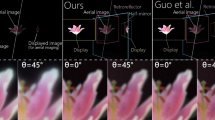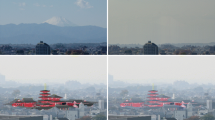Abstract
In Virtual Reality (VR) and computer graphic fields, 3-dimension (3D) matter modeling has been developed for many years and successfully applied to many fields. However, researches on 3D energy field modeling are still not enough owing to challenges of full understanding and real-time calculation of invisible energy fields. In the visual information world, energy field modeling is becoming a new research point and should promote relevant research advancement and widen applications. In the paper, after reviewing the 3D object modeling, light field modeling is addressed from three aspects which contain light propagation characteristic, bidirectional reflectance distribution function (BRDF), sunlight transfer process between solar source and observers. Especially the quantitative radiances at ground level and aircraft/space level are presented. According to the sunlight transfer process, a research framework of Remote Sensing Image Simulation (RSIS) is proposed and an experiment is implemented. Our study shows that light field modeling can make invisible energy fields easily-understood and demonstrate an example of multi-sciences integration research.
Access this chapter
Tax calculation will be finalised at checkout
Purchases are for personal use only
Preview
Unable to display preview. Download preview PDF.
Similar content being viewed by others
References
Berk, A., Anderson, G.P., Acharya, P.K., Chetwynd, J.H., Bernstein, L.S., Shettle, E.P., Matthew, M.W., Adler-Golden, S.M.: MODTRAN4 USER’s MANUAL. Hanscom AFB: Air Force Research Laboratory, Space Vehicles Directorate, Air Force Materiel Command, MA 01731-3010 (2000)
Bowyer, K.W.: Special issue on directions in CAD-based vision. In: CVGIP, vol. 55, pp. 107–108 (1992)
Camahort, E., Lerios, A., Fussell, D.: Uniformly sampled light fields. In: Ninth Eurographics Workshop on Rendering, Vienna, Austria, pp. 117–130 (1998)
Hilton, A.: Scene modelling from sparse 3D data. Image and Vision Computing 23, 900–920 (2005)
Hsu, S.S., Ashton, S., Beltsville, M.D.: Simulation of visible and IR imagery for GOES. In: Proceedings of IEEE International Geoscience and Remote Sensing Symposium, Pasadena, CA, USA, August 8-12, vol. 3, pp. 1546–1548 (1994)
Isaksen, A., McMillan, L., Gortler, S.J.: Dynamically reparameterized light fields. In: Proceedings of SIGGRAPH 2000, Computer Graphics Proceedings. Annual Conference Series, pp. 297–306 (2000)
Kang, S.B.: A survey of image-based rendering techniques. In: SPIE International Symposium on Electronic Imaging: Science and technology, San Jose, CA, vol. 3641, pp. 2–16 (1999)
Kerekes, J.P., Landgrebe, D.A.: RSSIM: A simulation program for optical remote sensing systems. TR-EE 89-48, School of Electrical Engineering, Purdue University, West Lafeyette, IN (August 1989)
Montero, G., Sanín, N.: 3-D Modelling of wind field adjustment using finite differences in a terrain conformal coordinate system. Journal of Wind Engineering and Industrial Aerodynamics 89, 471–488 (2001)
Pentland, A.P.: Automatic extraction of deformable part models. International Journal of Computer Vision 4, 107–126 (1990)
Schopfer, J., Dangel, S., Kneubühler, M.: Introduction to BRDF effects, http://www.geo.unizh.ch/rsl/research/SpectroLab/goniometry/brdf_intro.shtml
Szymon, R.: A survey of BRDF representation for computer graphics. Paper for CS 348C at Stanford U., Winter (1997)
Voloboi, A.G., Galaktionov, V.A., Dmitriev, K.A., Kopylov, E.A.: Bidirectional ray tracing for the integration of illumination by the Quasi-Monte Carlo method. Programming and Computer Software 30(5), 258–265 (2004)
Whitaker, S.: Simultaneous heat, mass and momentum transfers in porous media: a theory of drying. Adv. Heat Transfer 13, 119–203 (1977)
Author information
Authors and Affiliations
Editor information
Editors and Affiliations
Rights and permissions
Copyright information
© 2006 Springer-Verlag Berlin Heidelberg
About this paper
Cite this paper
Huang, M., Gong, J., Shi, Z., Zhang, L. (2006). Light Field Modeling and Its Application to Remote Sensing Image Simulation. In: Pan, Z., Cheok, A., Haller, M., Lau, R.W.H., Saito, H., Liang, R. (eds) Advances in Artificial Reality and Tele-Existence. ICAT 2006. Lecture Notes in Computer Science, vol 4282. Springer, Berlin, Heidelberg. https://doi.org/10.1007/11941354_73
Download citation
DOI: https://doi.org/10.1007/11941354_73
Publisher Name: Springer, Berlin, Heidelberg
Print ISBN: 978-3-540-49776-9
Online ISBN: 978-3-540-49779-0
eBook Packages: Computer ScienceComputer Science (R0)




